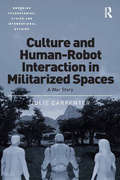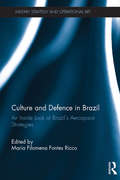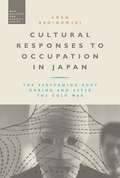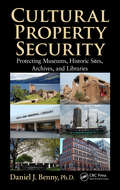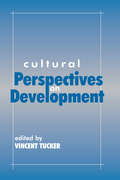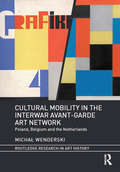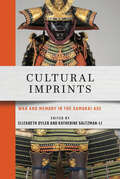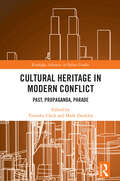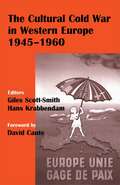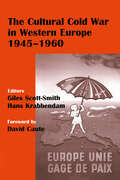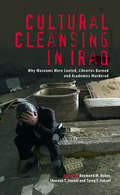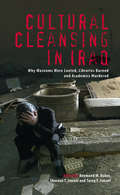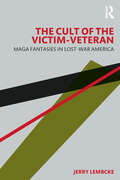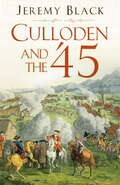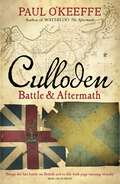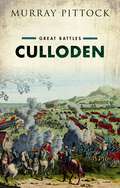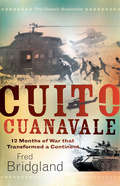- Table View
- List View
Culture and Human-Robot Interaction in Militarized Spaces: A War Story (Emerging Technologies, Ethics and International Affairs)
by Julie CarpenterExplosive Ordnance Disposal (EOD) personnel are some of the most highly trained people in the military, with a job description that spans defusing unexploded ordnance to protecting VIP’s and state dignitaries. EOD are also one of the first military groups to work with robots every day. These robots have become an increasingly important tool in EOD work, enabling people to work at safer distances in many dangerous situations. Based on exploratory research investigating interactions between EOD personnel and the robots they use, this study richly describes the nuances of these reciprocal influences, especially those related to operator emotion associated with the robots. In particular, this book examines the activities, processes and contexts that influence or constrain everyday EOD human-robot interactions, what human factors are shaping the (robotic) technology and how people and culture are being changed by using it. The findings from this research have implications for future personnel training, and the refinement of robot design considerations for many fields that rely on critical small group communication and decision-making skills.
Culture and Defence in Brazil: An Inside Look at Brazil's Aerospace Strategies (Military Strategy and Operational Art)
by Maria Filomena Fontes RiccoThis volume examines the connection between culture and defence by providing an inside look at Brazil’s aerospace strategies. Brazil is becoming increasingly important geopolitically, and several studies have sought to further understanding of this new position in the international arena. This volume aims to provide a better understanding of the Brazilian nation, its security dilemmas, and how the country seeks to develop its defence training process and improve its professional military education. Organised into two parts, the chapters offer academic dialogues on several aspects of this topic, including public politics and the law, joint operations, human factors and the government interchanges with industry. The first section analyses Brazilian defence policy and strategy, discussing different aspects of aerospace power and Brazilian security perspectives. Chapters discuss the relationship between Brazil and the United States, which blend aspects of the generation of knowledge, science, technology and innovation, and point to economic issues and the Defence Industrial Base. Specific implications of the Brazilian air space, compared with Europe and the United States, also are exposed. In addition, a vision of cyberspace implications for the national power, a present-day question for the entire planet, is also presented. Thereafter, the second section looks at specific aspects of professional military education and explains the Brazilian approach to strengthening its aerospace power. This includes military education and performance, interdisciplinary studies, working jointly, multivariate analysis and cases. This book will be of much interest to students of military studies, defence studies, gender issues, crises management and decision making, Latin American politics and International Relations in general.
Culture and Defence in Brazil: An Inside Look at Brazil's Aerospace Strategies (Military Strategy and Operational Art)
by Maria Filomena Fontes RiccoThis volume examines the connection between culture and defence by providing an inside look at Brazil’s aerospace strategies. Brazil is becoming increasingly important geopolitically, and several studies have sought to further understanding of this new position in the international arena. This volume aims to provide a better understanding of the Brazilian nation, its security dilemmas, and how the country seeks to develop its defence training process and improve its professional military education. Organised into two parts, the chapters offer academic dialogues on several aspects of this topic, including public politics and the law, joint operations, human factors and the government interchanges with industry. The first section analyses Brazilian defence policy and strategy, discussing different aspects of aerospace power and Brazilian security perspectives. Chapters discuss the relationship between Brazil and the United States, which blend aspects of the generation of knowledge, science, technology and innovation, and point to economic issues and the Defence Industrial Base. Specific implications of the Brazilian air space, compared with Europe and the United States, also are exposed. In addition, a vision of cyberspace implications for the national power, a present-day question for the entire planet, is also presented. Thereafter, the second section looks at specific aspects of professional military education and explains the Brazilian approach to strengthening its aerospace power. This includes military education and performance, interdisciplinary studies, working jointly, multivariate analysis and cases. This book will be of much interest to students of military studies, defence studies, gender issues, crises management and decision making, Latin American politics and International Relations in general.
Cultural Responses to Occupation in Japan: The Performing Body During and After the Cold War (War, Culture and Society)
by Adam BroinowskiCultural Responses to Occupation in Japan examines how the performing arts, and the performing body specifically, have shaped and been shaped by the political and historical conditions experienced in Japan during the Cold War and post-Cold War periods. This study of original and secondary materials from the fields of theatre, dance, performance art, film and poetry, probes the interrelationship that exists between the body and the nation-state. Important artistic works, such as Ankoku Butoh (dance of darkness) and its subsequent re-interpretation by a leading political performance company Gekidan Kaitaisha (theatre of deconstruction), are analysed using ethnographic, historical and theoretical modes. This approach reveals the nuanced and prolonged effects of military, cultural and political occupation in Japan over a duration of dramatic change.Cultural Responses to Occupation in Japan explores issues of discrimination, marginality, trauma, memory and the mediation of history in a ground-breaking work that will be of great significance to anyone interested in the symbiosis of culture and conflict.
Cultural Responses to Occupation in Japan: The Performing Body During and After the Cold War (War, Culture and Society)
by Adam BroinowskiCultural Responses to Occupation in Japan examines how the performing arts, and the performing body specifically, have shaped and been shaped by the political and historical conditions experienced in Japan during the Cold War and post-Cold War periods. This study of original and secondary materials from the fields of theatre, dance, performance art, film and poetry, probes the interrelationship that exists between the body and the nation-state. Important artistic works, such as Ankoku Butoh (dance of darkness) and its subsequent re-interpretation by a leading political performance company Gekidan Kaitaisha (theatre of deconstruction), are analysed using ethnographic, historical and theoretical modes. This approach reveals the nuanced and prolonged effects of military, cultural and political occupation in Japan over a duration of dramatic change.Cultural Responses to Occupation in Japan explores issues of discrimination, marginality, trauma, memory and the mediation of history in a ground-breaking work that will be of great significance to anyone interested in the symbiosis of culture and conflict.
Cultural Property Security: Protecting Museums, Historic Sites, Archives, and Libraries
by Daniel J. BennyThe protection and security of cultural properties is of primary concern to the thousands of federal, state, county, city, and private institutions entrusted with housing and displaying our national heritage and history of our society. Cultural property security is of global importance as well, with tens of thousands of institutions internationally
Cultural Perspectives on Development (European Association Of Development Research And Training Institutes (eadi), Geneva, Book Ser.)
by Vincent TuckerWhat does cultural analysis have to offer development studies? Is culture a new paradigm for the study of development or a minefield of theoretical confusion? Can we move beyond notions of global culture' and local culture' to a more refined notion of cultural processes?This collection of articles addresses these issues providing a diversity of approaches. Two themes in particular run through the contributions: the relationship between culture and political economy and the relationship between local and global processes.
Cultural Perspectives on Development
by Vincent TuckerWhat does cultural analysis have to offer development studies? Is culture a new paradigm for the study of development or a minefield of theoretical confusion? Can we move beyond notions of global culture' and local culture' to a more refined notion of cultural processes?This collection of articles addresses these issues providing a diversity of approaches. Two themes in particular run through the contributions: the relationship between culture and political economy and the relationship between local and global processes.
Cultural Mobility in the Interwar Avant-Garde Art Network: Poland, Belgium and the Netherlands (Routledge Research in Art History)
by Michał WenderskiThis book explores the issue of cultural mobility within the interwar network of the European avant-garde, focusing on selected writers, artists, architects, magazines and groups from Poland, Belgium and Netherlands. Regardless of their apparent linguistic, cultural and geographical remoteness, their mutual exchange and relationships were both deep and broad, and of great importance for the wider development of interwar avant-garde literature, art and architecture. This analysis is based on a vast research corpus encompassing original, often previously overlooked periodicals, publications and correspondence gathered from archives around the world.
Cultural Mobility in the Interwar Avant-Garde Art Network: Poland, Belgium and the Netherlands (Routledge Research in Art History)
by Michał WenderskiThis book explores the issue of cultural mobility within the interwar network of the European avant-garde, focusing on selected writers, artists, architects, magazines and groups from Poland, Belgium and Netherlands. Regardless of their apparent linguistic, cultural and geographical remoteness, their mutual exchange and relationships were both deep and broad, and of great importance for the wider development of interwar avant-garde literature, art and architecture. This analysis is based on a vast research corpus encompassing original, often previously overlooked periodicals, publications and correspondence gathered from archives around the world.
Cultural Imprints: War and Memory in the Samurai Age
by Elizabeth OylerCultural Imprints draws on literary works, artifacts, performing arts, and documents that were created by or about the samurai to examine individual "imprints," traces holding specifically grounded historical meanings that persist through time. The contributors to this interdisciplinary volume assess those imprints for what they can suggest about how thinkers, writers, artists, performers, and samurai themselves viewed warfare and its lingering impact at various points during the "samurai age," the long period from the establishment of the first shogunate in the twelfth century through the fall of the Tokugawa in 1868. The range of methodologies and materials discussed in Cultural Imprints challenges a uniform notion of warrior activity and sensibilities, breaking down an ahistorical, monolithic image of the samurai that developed late in the samurai age and that persists today. Highlighting the memory of warfare and its centrality in the cultural realm, Cultural Imprints demonstrates the warrior's far-reaching, enduring, and varied cultural influence across centuries of Japanese history.Contributors: Monica Bethe, William Fleming, Andrew Goble, Thomas Hare, Luke Roberts, Marimi Tateno, Alison Tokita, Elizabeth Oyler, Katherine Saltzman-Li
Cultural Heritage in Modern Conflict: Past, Propaganda, Parade (Routledge Advances in Defence Studies)
by Timothy Clack Mark DunkleyThis edited volume offers an in-depth study of heritage and warfare from the perspective of defence studies. The book focuses on how, in different contexts, heritage can be a catalyst and target of conflict, an obstacle to stabilisation, and a driver of peace-building. It documents the changing role of heritage – in terms of both exploitation and protection – in various military capabilities, theatres, and operations. With particular concern for the areas of subthreshold and hybrid warfare, stabilisation, cultural relationships, human security, and disaster response, the volume reviews the historical relationship between heritage and armed conflict, including the roles of embedded archaeologists, safeguarding of ethics, and dislodgement and destruction of material culture. Various chapters in the book also demonstrate the value of understanding how state and non-state actors exploit cultural heritage across different defence postures and within both subthreshold and proxy warfare in order to achieve military, political, economic, and diplomatic advantages. This book will be of interest to students of defence studies, heritage studies, anthropology and security studies in general, as well as military practitioners.
Cultural Heritage in Modern Conflict: Past, Propaganda, Parade (Routledge Advances in Defence Studies)
by Timothy Clack Mark DunkleyThis edited volume offers an in-depth study of heritage and warfare from the perspective of defence studies. The book focuses on how, in different contexts, heritage can be a catalyst and target of conflict, an obstacle to stabilisation, and a driver of peace-building. It documents the changing role of heritage – in terms of both exploitation and protection – in various military capabilities, theatres, and operations. With particular concern for the areas of subthreshold and hybrid warfare, stabilisation, cultural relationships, human security, and disaster response, the volume reviews the historical relationship between heritage and armed conflict, including the roles of embedded archaeologists, safeguarding of ethics, and dislodgement and destruction of material culture. Various chapters in the book also demonstrate the value of understanding how state and non-state actors exploit cultural heritage across different defence postures and within both subthreshold and proxy warfare in order to achieve military, political, economic, and diplomatic advantages. This book will be of interest to students of defence studies, heritage studies, anthropology and security studies in general, as well as military practitioners.
The Cultural Cold War in Western Europe, 1945-60 (Studies in Intelligence)
by Hans Krabbendam Giles Scott-SmithThe idea of the Cold War as a propaganda contest as opposed to a military conflict is being increasingly accepted. This has led to a re-evaluation of the relationship between economic policies, political agendas and cultural activities in Western Europe post 1945.This book provides an important cross-section of case studies that highlight the connections between overt/covert activities and cultural/political agendas during the early Cold War. It therefore provides a valuable bridge between diplomatic and intelligence research and represents an important contribution towards our understanding of the significance and consequences of this linkage for the shaping of post-war democratic societies.
The Cultural Cold War in Western Europe, 1945-60 (Studies in Intelligence)
by Giles Scott-Smith Hans KrabbendamThe idea of the Cold War as a propaganda contest as opposed to a military conflict is being increasingly accepted. This has led to a re-evaluation of the relationship between economic policies, political agendas and cultural activities in Western Europe post 1945.This book provides an important cross-section of case studies that highlight the connections between overt/covert activities and cultural/political agendas during the early Cold War. It therefore provides a valuable bridge between diplomatic and intelligence research and represents an important contribution towards our understanding of the significance and consequences of this linkage for the shaping of post-war democratic societies.
Cultural Cleansing in Iraq: Why Museums Were Looted, Libraries Burned and Academics Murdered
by Raymond W. Baker Shereen T. Ismael Tareq Y. IsmaelWhy did the invasion of Iraq result in the destruction of culture and murder of intellectuals? Convention sees accidents of war and poor planning in a campaign to liberate Iraqis. The authors argue instead that the invasion aimed to dismantle the Iraqi state to remake it as a client regime. *BR**BR*Post-invasion chaos created conditions under which the cultural foundations of the state could be undermined. The authors painstakingly document the consequences of the occupiers' wilful inaction and worse, which led to the ravaging of one of the world's oldest recorded cultures. Targeted assassination of over 400 academics, kidnapping and the forced flight of thousands of doctors, lawyers, artists and other intellectuals add up to cultural cleansing.*BR**BR*This book lays to rest claims that the invasion aimed to free an educated population to develop its own culture of democracy.
Cultural Cleansing in Iraq: Why Museums Were Looted, Libraries Burned and Academics Murdered
by Tareq Y. Ismael Raymond W. Baker Shereen T. IsmaelWhy did the invasion of Iraq result in the destruction of culture and murder of intellectuals? Convention sees accidents of war and poor planning in a campaign to liberate Iraqis. The authors argue instead that the invasion aimed to dismantle the Iraqi state to remake it as a client regime. *BR**BR*Post-invasion chaos created conditions under which the cultural foundations of the state could be undermined. The authors painstakingly document the consequences of the occupiers' wilful inaction and worse, which led to the ravaging of one of the world's oldest recorded cultures. Targeted assassination of over 400 academics, kidnapping and the forced flight of thousands of doctors, lawyers, artists and other intellectuals add up to cultural cleansing.*BR**BR*This book lays to rest claims that the invasion aimed to free an educated population to develop its own culture of democracy.
The Cult of the Victim-Veteran: MAGA Fantasies in Lost-war America
by Jerry LembckeThe Cult of the Victim-Veteran explores the pool of American post- Vietnam War angst that rightists began plying in the 1980s. Ronald Reagan’s 1984 proclamation of a new "Morning in America" encoded the war as the moment of the nation’s fall from grace; it was the meme plagiarized by Donald Trump for his "Make America Great Again" (MAGA) slogan. The national funk tapped for right- wing revanchism was psychologized when George H.W. Bush appropriated post- Vietnam syndrome, the diagnostic forerunner to post- traumatic stress disorder (PTSD), to memorialize the military accomplishments in the Persian Gulf War of 1990–1991—we had "kicked the Vietnam Syndrome." America was a victim- nation, its trauma emblemized by PTSD-stricken veterans whose war mission had been lost on the home front, cast aside, even spat on, upon return home. In this book we see the long historical threads woven for MAGA: the twining of traditional and modern ways of knowing that imbues war trauma with political and cultural properties that complicate its diagnostic use; the post- World War I disclosure that many shellshock patients had never been exposed to exploding shells, and the use of wounded- veteran imagery to fan the flames of German fascism; the cultural necessity of reimaging antiwar Vietnam veterans as psychiatric casualties that calls forth a new diagnostic category, PTSD; the derivatizing of PTSD for traumatic brain injury, Agent Orange, and moral injury; and the victim- veteran figure as metaphor for a wounded America, for which MAGA is the remedy.
The Cult of the Victim-Veteran: MAGA Fantasies in Lost-war America
by Jerry LembckeThe Cult of the Victim-Veteran explores the pool of American post- Vietnam War angst that rightists began plying in the 1980s. Ronald Reagan’s 1984 proclamation of a new "Morning in America" encoded the war as the moment of the nation’s fall from grace; it was the meme plagiarized by Donald Trump for his "Make America Great Again" (MAGA) slogan. The national funk tapped for right- wing revanchism was psychologized when George H.W. Bush appropriated post- Vietnam syndrome, the diagnostic forerunner to post- traumatic stress disorder (PTSD), to memorialize the military accomplishments in the Persian Gulf War of 1990–1991—we had "kicked the Vietnam Syndrome." America was a victim- nation, its trauma emblemized by PTSD-stricken veterans whose war mission had been lost on the home front, cast aside, even spat on, upon return home. In this book we see the long historical threads woven for MAGA: the twining of traditional and modern ways of knowing that imbues war trauma with political and cultural properties that complicate its diagnostic use; the post- World War I disclosure that many shellshock patients had never been exposed to exploding shells, and the use of wounded- veteran imagery to fan the flames of German fascism; the cultural necessity of reimaging antiwar Vietnam veterans as psychiatric casualties that calls forth a new diagnostic category, PTSD; the derivatizing of PTSD for traumatic brain injury, Agent Orange, and moral injury; and the victim- veteran figure as metaphor for a wounded America, for which MAGA is the remedy.
Culloden and the '45
by Jeremy BlackThe Jacobite ’45 rebellion was one of the greatest challenges to the eighteenth-century British state, and the Battle of Culloden in which it culminated was certainly one of the most dramatic of the century. Based on extensive archival research, Culloden and the ’45 examines the political and military context of the uprising and highlights the seriousness of the challenge posed by the Jacobites. The result is an illuminating account of an episode often obscured by the perspectives of Stuart romance.
Culloden: Battle & Aftermath
by Paul O'KeeffeCharles Edward Stuart's campaign to seize the British throne on behalf of his exiled father ended with one of the quickest defeats in history: on 16 April 1746, at Culloden, his 5,000-strong Jacobite army was decisively overpowered in under forty minutes. Its brutal repercussions, however, endured for months and years, its legacy for centuries.Paul O'Keeffe follows the Jacobite army, from its initial victories over Hanoverian troops at Prestonpans, Clifton and Falkirk to their calamitous defeat on the field of Culloden. He explores the battle's aftermath which claimed the lives, not only of helpless wounded summarily executed and fugitives cut down by pursuing dragoons, but also of civilians slaughtered by vengeful government patrols as they 'pacified' the Highlands. He chronicles the wild, nationwide celebration greeting news of the government victory, the London stage catering to patriotic fervour with new songs like 'God Save the King', popular musical theatre, and operas by Gluck and Handel. Meanwhile, the public was also treated to the grimmer spectacle of Jacobite prisoners, tried for high treason, paying for their participation on block and gibbet throughout the country. Many others - granted 'the King's mercy' - suffered the lingering fate of forced labour on fever-ridden plantations in the West Indies and Virginia. O'Keeffe reveals the unexpected consequences of the rising - mapping the Scottish Highlands to aid military subjugation would eventually lead to the foundation of the Ordnance Survey - and traces the later careers of the battle's protagonists: the Duke of Cumberland's transformation from idolised national hero to discredited 'butcher'; Charles Edward Stuart's from 'Bonny Prince' to embittered alcoholic invalid. While in the long term the doomed Stuart cause acquired an aura of romanticism, the Jacobite Rising of 1745-46 remains one of the most bloody and divisive conflicts in British domestic history, which resonates to this day.
Culloden: Great Battles (Great Battles)
by Murray PittockThe battle of Culloden lasted less than an hour. The forces involved on both sides were small, even by the standards of the day. And it is arguable that the ultimate fate of the 1745 Jacobite uprising had in fact been sealed ever since the Jacobite retreat from Derby several months before. But for all this, Culloden is a battle with great significance in British history. It was the last pitched battle on the soil of the British Isles to be fought with regular troops on both sides. It came to stand for the final defeat of the Jacobite cause. And it was the last domestic contestation of the Act of Union of 1707, the resolution of which propelled Great Britain to be the dominant world power for the next 150 years. If the battle itself was short, its aftermath was brutal - with the depredations of the Duke of Cumberland followed by a campaign to suppress the clan system and the Highland way of life. And its afterlife in the centuries since has been a fascinating one, pitting British Whig triumphalism against a growing romantic memorialization of the Jacobite cause. On both sides there has long been a tendency to regard the battle as a dramatic clash, between Highlander and Lowlander, Celt and Saxon, Catholic and Protestant, the old and the new. Yet, as this account of the battle and its long cultural afterlife suggests, while viewing Culloden in such a way might be rhetorically compelling, it is not necessarily good history.
Culloden: Great Battles (Great Battles)
by Murray PittockThe battle of Culloden lasted less than an hour. The forces involved on both sides were small, even by the standards of the day. And it is arguable that the ultimate fate of the 1745 Jacobite uprising had in fact been sealed ever since the Jacobite retreat from Derby several months before. But for all this, Culloden is a battle with great significance in British history. It was the last pitched battle on the soil of the British Isles to be fought with regular troops on both sides. It came to stand for the final defeat of the Jacobite cause. And it was the last domestic contestation of the Act of Union of 1707, the resolution of which propelled Great Britain to be the dominant world power for the next 150 years. If the battle itself was short, its aftermath was brutal - with the depredations of the Duke of Cumberland followed by a campaign to suppress the clan system and the Highland way of life. And its afterlife in the centuries since has been a fascinating one, pitting British Whig triumphalism against a growing romantic memorialization of the Jacobite cause. On both sides there has long been a tendency to regard the battle as a dramatic clash, between Highlander and Lowlander, Celt and Saxon, Catholic and Protestant, the old and the new. Yet, as this account of the battle and its long cultural afterlife suggests, while viewing Culloden in such a way might be rhetorically compelling, it is not necessarily good history.
A Culinary Campaign (The World At War)
by Alexis SoyerSoyer's brilliant memoir, a vivid account of the Crimean War and of Soyer's inventions and recipes for feeding armies in the field. He was as important in the Crimea as Florence Nightingale, for his influence on the reform of army feeding enabled wounded soldiers to survive. A modified version of the Soyer stove was still in use in the Gulf War. (Goodreads)
Cuito Cuanavale: 12 Months of War that Transformed a Continent
by Fred BridglandBy September 1987 Angola’s army – supported by Cuba and a billion dollars of arms from the Soviet Union – had assembled massive forces on the Lomba River, 125 km southeast of the Angolan town of Cuito Cuanavale. Their goal? To capture Jamba, headquarters of the rebel group Unita, supported by the South African Defence Force (SADF) in the so-called Border War. The fighting eventually centred around Cuito Cuanavale after a massive battle on the Lomba, where 3 000 SADF soldiers and 8 000 Unita fighters were up against an Angolan–Cuban force of more than 50 000 men. Thousands died in the fighting, vividly and dramatically retold by Bridgland from interviews with scores of men who were on the front line. Thirty years later the question of who won the war still leads to vigorous debate. The final outcome of the war had an impact far beyond the borders of Angola and Namibia. It spelled the end of the last great neo-colonial attempts at African conquest by Cuba and the former Soviet Union and also made possible the dismantling of apartheid in South Africa.
